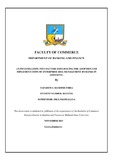Please use this identifier to cite or link to this item:
https://cris.library.msu.ac.zw//handle/11408/2219| Title: | An investigation into factors influencing the adoption and implementation of enterprise risk management by banks in Zimbabwe. | Authors: | Mandimutsira, Tafadzwa | Keywords: | Enterprise risk management. | Issue Date: | Nov-2015 | Publisher: | Midlands State University | Abstract: | This research focuses on the factors that influence the adoption and implementation of enterprise risk management practices by banks in Zimbabwe. In the recent years a lot of bank failures have been recorded and this is as a result of failure to monitor or acknowledge the risks that an institution is exposed to in the dynamic environment. Therefore the research intends to identify the internal and external factors that are making banks consider the adoption of a holistic approach to risk management. It has been noted from the literature that surrounds the area of the study that there are a lot of factors that influence the adoption and implementation of ERM amongst which are firm size, complexity, asset opacity, leverage, regulation, independence of board and culture. Different authors also highlight that there are challenges that are faced in the process and these are the inventory of risks, inappropriate system and challenges related to the process. It is also said that if adopted and implemented ERM had a positive relationship with firm performance which is realized in the long run. The research adopted both the explanatory and descriptive research designs in a quest to understand the relationship between the various factors and ERM adoption and to have a clear understanding of the challenges faced and the significance of ERM on banks respectively. The research made use of questionnaires directed to branch managers and secondary data obtained from annual reports of the banking institutions and the monetary policy statements. Factor analysis and logistic regression were used to obtain the results for the research. It was observed that some of the banking institutions in Zimbabwe have adopted ERM and the main factors influencing adoption were size, complexity and leverage and opacity. It was also noted that banks are faced with challenges in ascertaining the aggregate risk that they are exposed to and also they highlighted that ERM requires a lot of resources and commitment. The researcher recommend banks to consider the use of simple frameworks that are less complex and try and minimize the resources needed for the adoption and implementation process. It is also important to realize that ERM is a continuous movement that has to be taken seriously with each stage as the organization grows. | URI: | http://hdl.handle.net/11408/2219 |
| Appears in Collections: | Bachelor Of Commerce Banking And Finance Honours Degree |
Files in This Item:
| File | Description | Size | Format | |
|---|---|---|---|---|
| TAFADZWA.pdf | Full text | 886.23 kB | Adobe PDF |  View/Open |
Page view(s)
204
checked on Jan 14, 2025
Download(s)
134
checked on Jan 14, 2025
Google ScholarTM
Check
Items in MSUIR are protected by copyright, with all rights reserved, unless otherwise indicated.


